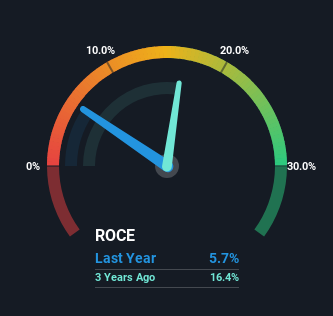- Saudi Arabia
- /
- Metals and Mining
- /
- SASE:9523
Investors Could Be Concerned With Group Five Pipe Saudi's (TADAWUL:9523) Returns On Capital
What financial metrics can indicate to us that a company is maturing or even in decline? Businesses in decline often have two underlying trends, firstly, a declining return on capital employed (ROCE) and a declining base of capital employed. Basically the company is earning less on its investments and it is also reducing its total assets. So after we looked into Group Five Pipe Saudi (TADAWUL:9523), the trends above didn't look too great.
Understanding Return On Capital Employed (ROCE)
Just to clarify if you're unsure, ROCE is a metric for evaluating how much pre-tax income (in percentage terms) a company earns on the capital invested in its business. Analysts use this formula to calculate it for Group Five Pipe Saudi:
Return on Capital Employed = Earnings Before Interest and Tax (EBIT) ÷ (Total Assets - Current Liabilities)
0.057 = ر.س27m ÷ (ر.س1.2b - ر.س768m) (Based on the trailing twelve months to June 2023).
Therefore, Group Five Pipe Saudi has an ROCE of 5.7%. In absolute terms, that's a low return and it also under-performs the Metals and Mining industry average of 11%.
Check out our latest analysis for Group Five Pipe Saudi

While the past is not representative of the future, it can be helpful to know how a company has performed historically, which is why we have this chart above. If you want to delve into the historical earnings , check out these free graphs detailing revenue and cash flow performance of Group Five Pipe Saudi.
What Can We Tell From Group Five Pipe Saudi's ROCE Trend?
In terms of Group Five Pipe Saudi's historical ROCE movements, the trend doesn't inspire confidence. To be more specific, the ROCE was 16% three years ago, but since then it has dropped noticeably. On top of that, it's worth noting that the amount of capital employed within the business has remained relatively steady. Since returns are falling and the business has the same amount of assets employed, this can suggest it's a mature business that hasn't had much growth in the last three years. If these trends continue, we wouldn't expect Group Five Pipe Saudi to turn into a multi-bagger.
On a side note, Group Five Pipe Saudi's current liabilities are still rather high at 62% of total assets. This effectively means that suppliers (or short-term creditors) are funding a large portion of the business, so just be aware that this can introduce some elements of risk. While it's not necessarily a bad thing, it can be beneficial if this ratio is lower.
What We Can Learn From Group Five Pipe Saudi's ROCE
In the end, the trend of lower returns on the same amount of capital isn't typically an indication that we're looking at a growth stock. However the stock has delivered a 66% return to shareholders over the last year, so investors might be expecting the trends to turn around. In any case, the current underlying trends don't bode well for long term performance so unless they reverse, we'd start looking elsewhere.
If you want to know some of the risks facing Group Five Pipe Saudi we've found 3 warning signs (2 are significant!) that you should be aware of before investing here.
While Group Five Pipe Saudi isn't earning the highest return, check out this free list of companies that are earning high returns on equity with solid balance sheets.
New: Manage All Your Stock Portfolios in One Place
We've created the ultimate portfolio companion for stock investors, and it's free.
• Connect an unlimited number of Portfolios and see your total in one currency
• Be alerted to new Warning Signs or Risks via email or mobile
• Track the Fair Value of your stocks
Have feedback on this article? Concerned about the content? Get in touch with us directly. Alternatively, email editorial-team (at) simplywallst.com.
This article by Simply Wall St is general in nature. We provide commentary based on historical data and analyst forecasts only using an unbiased methodology and our articles are not intended to be financial advice. It does not constitute a recommendation to buy or sell any stock, and does not take account of your objectives, or your financial situation. We aim to bring you long-term focused analysis driven by fundamental data. Note that our analysis may not factor in the latest price-sensitive company announcements or qualitative material. Simply Wall St has no position in any stocks mentioned.
About SASE:9523
Group Five Pipe Saudi
Engages in the production and sale of spirally welded pipes in the Middle East and North Africa region.
Proven track record with slight risk.
Market Insights
Community Narratives



